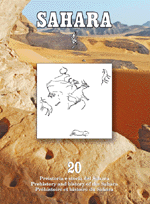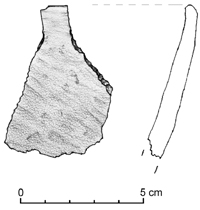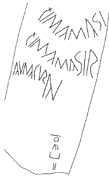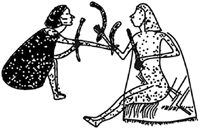| Contents
Abstracts |
(published July 2009) |
||
 |
|||
The Rock Art of the Acacus Mountains (SW Libya), between originals and copies
Despite its enormous complexity and richness the rock art of the Sahara does not occupy the prominent position in international scholarship which it certainly deserves. One possible reason for this is linked to the often slapdash procedures typical of field work at the time when Saharan art rose to fame, the mid-20th century. This article, which summarizes a multi-faceted research project, analyses one specific aspect of the painted rock art of the Acacus (south-western Libya): the reproductions made and published by F. Mori from 1960 onwards. Having come to represent the official iconography for prehistoric Libyan art, these fine reproductions on closer inspection reveal errors and inaccuracies, to be considered as the result of academic strategies and of the historical and cultural climate of our not so distant past. Work to contextualize these reproductions undertaken between 2001 and 2004 has made it possible to use this important collection of copies in a new way, contributing to a new awareness within the Saharan scientific community, that has concentrated excessively on style and expended little effort on the integrated analysis of art works. |
|||
|
|
31 |
ABSTRACT
|
|
57 |
|
 |
The Sheikh Muftah cultural unit is an archaeological term used to distinguish a specific group of people who lived as pastoral nomads in the Egyptian oases during the 4th and 3rd millennium calBC. It would appear that the Sheikh Muftah culture was concentrated particularly in the oases of Dakhla and Kharga, and until recently there was no evidence for dispersal into the oases further to the north or northwest. A Sheikh Muftah potsherd found at the fringe of the Great Sand Sea northwest of Abu Minqar now suggests that Sheikh Muftah activities were obviously far more widespread than believed
| 63 |
(FREE FULL-TEXT ARTICLE)
Landscape reconstruction of the Predynastic site at Nag el-Qarmila (Upper Egypt)
ABSTRACT
This short article wants to present the landscape reconstruction of a Predynastic site in the vicinity of Aswan. The site is unique because of the presence of both domestic and funerary contexts in a small valley close to the Nile. Landscape reconstruction with artistic drawings is an interesting method for presenting in a visual way archaeological information.

| 69 |
Borou Sud 06, quadri di un’esposizione (conca di Ouri, Tibesti nord-orientale, Ciad)
ABSTRACT
This paper is part of a study on Chadian rock art that has been going on for a few years, based on a rich photographic archive and on a series of observations in the field collected during several surveys in the years 1990s. The long painted wall of Borou Sud 06 presents an extraordinary quantity of paintings in an exceptional variety of subjects and styles. The paintings seems to suggest that a few human groups, with different lifestyles and conceptions of the otherworld, decided to leave their artistic expressions in this very place.
| 83 |
The colonization of the Canary Islands and the Libyco-Berber and Latino-Canarian scripts
 |
Since the emergence of Canarian archaeology in the 19th century, research into Canarian rock art, Libyco-Berber inscriptions and the colonization of the Canary Islands, within the North African context, presents several problems. This paper therefore analyses the evolution of research into Canarian rock art and Libyco-Berber inscriptions from a historical and diachronic perspective, and develops a new thesis concerning the origin of the Libyco-Berber script, based on new discoveries of inscriptions on the Canary Islands and in Morocco. In the light of this new thesis we propose a diachronic hypothesis for the ancient colonization of the Canary Islands.
| 101 |
L’ « époque des Chasseurs Anciens » dans la Tassili-n-Ajjer (Algérie du Sud)
 |
A large number of rock pictures, found during the last 15 years, lead us to the conclusion that not only the early“Roundhead” artists were producers of petroglyphs and pictographs at the same time – according to the existing local conditions – but also the artists of the“Ancient Hunters” of the Tassili Mountains. Especially examples of pictures exhibiting hippopotami evidence the different ways in which these two groups perceived their surroundings and are helpful in classifying rock art and establishing a chronology.
Top
